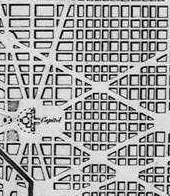
The debate over DC streetcars has heated up again with a new alliance against DDOT’s plans to install in-ground rails.
In a press release today, the Organization for Moderate Growth With Trackless Functioning and Better-than-Bus Quality announced that they would oppose any technology reliant on a guideway built into the streets of DC. The organization emphasizes the damage rails would do to the historic character of the roads within the Federal City. “Pierre Charles L’Enfant,” the statement reads, “never imagined streets crisscrossed by hideous steel rails. Maps from his period show clean, smooth streets with no indication of any disruptions of the classical beauty of the surfaces.”
Proponents of ground-supported streetcars have emphasized that rail-based vehicles did once crisscross the city. However, the press release seeks to preempt this criticism by arguing that that was an unfortunate aberration. “Washington, DC has a strong tradition of rail-free streets dating back to 1964, when city fathers fought hard to eliminate the unsightly and segregated street-rail system in favor of more democratic buses. Even in the transit-friendly times of the 1950s, the general public recognized that surface rails were an affront to America’s cultural heritage.”
Margarita Masguerra, a representative of OMGWTFBBQ insists her group fully supports the construction of streetcars. “The petition we are circulating emphasizes that we want to see diverse transit options for residents. Buses are not enough, sure. But streetcar tracks would be so devastating to the city’s image of large automobile boulevards that we want DDOT to stop and consider other options. “In Dnepropetrovsk, Ukraine, and Ponca City, OK, systems have been explored that employ no rails at all,” she continued, “Although we do not understand how these systems work.”

“Certain models from Boston and Philadelphia apparently hang from wires suspended above the line, creating the strongly defined structure that our organization recognizes as attracting growth.” Ms. Masguerra pointed out the results she had seen, but commented, “Speaking only for myself, I have been to Amsterdam and Dallas, and had there not been any rails, I think the streets with cafes and buildings could have been really nice places.”
Support for the group’s petition has come from a wide range of interest groups. Lon Anderson of the Mid-Atlantic chapter of the American Automobile Association questions the need for surface transit. “OMGWTFBBQ are too polite about the nonsense logic of these railroad people. If they want streetcars, can’t they just put more rails in the subway?”
Other opponents have raised the danger that in-ground tracks might pose to pedestrians. The increased incidence of tripping and stubbed toes is a genuine concern for small-footed locals. Amanda Hess, writing in the City Paper‘s Sexist blog, commented that “rails may disproportionately harm women, who are much more likely to be wearing heels,” saying that the supporters might have darker motives.
“The image of a woman fallen onto the tracks merely recapitulates a sexist image of a woman in need of saving before a big scary train. Sorry, the train died with vaudeville. No doubt, there are many “Nice Guy” transit fans just waiting for this possibility. Just because you help a woman up, doesn’t mean she wants you to take her back to your apartment for a little dissertation on railway signaling. Trust me, she probably doesn’t want to see your lunar signal, vintage or not.”
But even OMGWTFBBQ is willing to compromise and look at a variety of systems. The petition highlights the Wuppertal Schwebebahn, which suspends its rails in the air. “It’s a great system.” Masguerra says, “They’re hardly visible from the ground.” Another system mentioned is the Demontierbares Klappenschienenschutzsystem under consideration in Tübingen, Germany and Alexandria, Egypt. That technology employs panels that cover the rails when a train is not nearby. The tops of the panels can be inlaid with various road materials. When a train approaches the section of track, the panels lift up to reveal the rails and close when the train leaves. Also featured was Zeppelin Luftschifftechnik‘s guided semi-rigid airship system, which has been installed between 25 malls and 14 skyscrapers in Dubai.
Masguerra insists that her organization’s sole interest is in improving transit in the DC area. “Again, I just want to reiterate that we want to see streetcars in Washington,” she says, “And we’re committed to exploring all options to make that happen without rails.”
… and apparently Amanda Hess was pretty amused. No word from the Committee of 100.